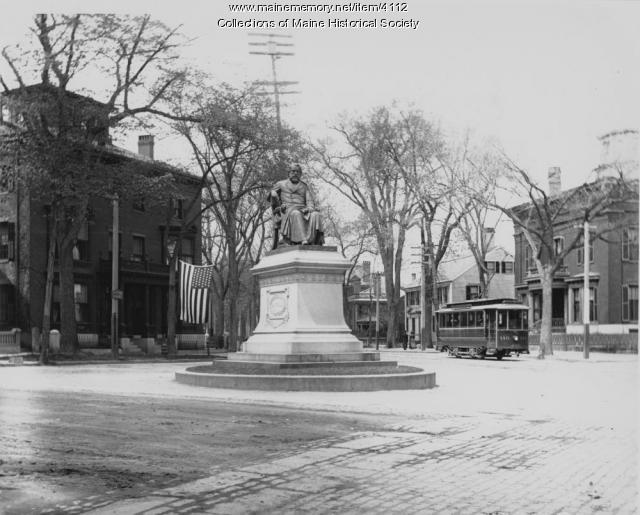Keywords: Longfellow Memorial
Item 4112
Statue of Henry Wadsworth Longfellow, Portland, ca. 1910
Contributed by: Maine Historical Society Date: circa 1910 Location: Portland Media: Photographic print
Item 5416
Doorway, Wadsworth-Longfellow House, Portland, ca. 1902
Contributed by: Maine Historical Society Date: circa 1902 Location: Portland Media: Photographic print
Exhibit
Longfellow: The Man Who Invented America
Henry Wadsworth Longfellow was a man and a poet of New England conscience. He was influenced by his ancestry and his Portland boyhood home and experience.
Exhibit
Drawing Together: Art of the Longfellows
Henry Wadsworth Longfellow is best know as a poet, but he also was accomplished in drawing and music. He shared his love of drawing with most of his siblings. They all shared the frequent activity of drawing and painting with their children. The extended family included many professional as well as amateur artists, and several architects.
Site Page
NPS, Longfellow House-Washington's Headquarters Historic Site
View collections, facts, and contact information for this Contributing Partner.
Site Page
View collections, facts, and contact information for this Contributing Partner.
Story
Monument Square 1967
by C. Michael Lewis
The background story and research behind a commissioned painting of Monument Square.
Story
Reverend Thomas Smith of First Parish Portland
by Kristina Minister, Ph.D.
Pastor, Physician, Real Estate Speculator, and Agent for Wabanaki Genocide
Lesson Plan
Portland History: "My Lost Youth" - Longfellow's Portland, Then and Now
Grade Level: 6-8, 9-12
Content Area: English Language Arts, Social Studies
Henry Wadsworth Longfellow loved his boyhood home of Portland, Maine. Born on Fore Street, the family moved to his maternal grandparents' home on Congress Street when Henry was eight months old. While he would go on to Bowdoin College and travel extensively abroad, ultimately living most of his adult years in Cambridge, Massachusetts, he never forgot his beloved Portland.
Years after his childhood, in 1855, he wrote "My Lost Youth" about his undiminished love for and memories of growing up in Portland. This exhibit, using the poem as its focus, will present the Portland of Longfellow's boyhood. In many cases the old photos will be followed by contemporary images of what that site looked like 2004.
Following the exhibit of 68 slides are five suggested lessons that can be adapted for any grade level, 3–12.
Lesson Plan
Grade Level: 3-5, 6-8, 9-12
Content Area: Social Studies, Visual & Performing Arts
"In the four quarters of the globe, who reads an American book?" Englishman Sydney Smith's 1820 sneer irked Americans, especially writers such as Irving, Cooper, Hawthorne, and Maine's John Neal, until Henry Wadsworth Longfellow's resounding popularity successfully rebuffed the question. The Bowdoin educated Portland native became the America's first superstar poet, paradoxically loved especially in Britain, even memorialized at Westminster Abbey. He achieved international celebrity with about forty books or translations to his credit between 1830 and 1884, and, like superstars today, his public craved pictures of him. His publishers consequently commissioned Longfellow's portrait more often than his family, and he sat for dozens of original paintings, drawings, and photos during his lifetime, as well as sculptures. Engravers and lithographers printed replicas of the originals as book frontispiece, as illustrations for magazine or newspaper articles, and as post cards or "cabinet" cards handed out to admirers, often autographed. After the poet's death, illustrators continued commercial production of his image for new editions of his writings and coloring books or games such as "Authors," and sculptors commemorated him with busts in Longfellow Schools or full-length figures in town squares. On the simple basis of quantity, the number of reproductions of the Maine native's image arguably marks him as the country's best-known nineteenth century writer. TEACHERS can use this presentation to discuss these themes in art, history, English, or humanities classes, or to lead into the following LESSON PLANS. The plans aim for any 9-12 high school studio art class, but they can also be used in any humanities course, such as literature or history. They can be adapted readily for grades 3-8 as well by modifying instructional language, evaluation rubrics, and targeted Maine Learning Results and by selecting materials for appropriate age level.















